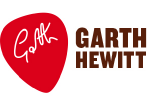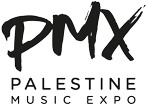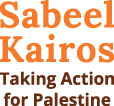“The road climbs and the heat builds. Nothing in my daily commute in flat old Cambridge has prepared me for thousand-foot climbs and 41 degrees.” Amos friend and cyclist Martin Clark writes about the first protest ride in Palestine.
Leaving behind the dusty dual carriageways of outer Tel Aviv, within an hour of cycling you are in the West Bank. Not that you would really know, as there are no official signs.
They don’t want you to know you are in a different territory that isn’t Israel. But there is a gradual increase in other types of signs — warnings about not handing your vehicle over to the Palestinian Authority, and not entering certain areas. For a first time visitor to the region, it’s all very mystifying.
The road climbs and the heat builds. Nothing in my daily commute in flat old Cambridge has prepared me for thousand foot climbs and 41 degrees. Our group of 8 is a mixed bunch of super tough club cyclists, both men and women, plus me and Chris from Amos.
They don’t want you to know you are in a different territory that isn’t Israel.
We quickly learn to work together to share the slipstream, warn of potholes, and encourage each other especially to make sure we don’t dehydrate on the first morning.
We see the first proper settlement and it seems to be surrounded by razor wire and observation towers. What’s going on? It’s a Palestinian village but with an Israeli military post unsubtly positioned in front of it. Look closer and there is a red sign warning Israelis not to enter as it is ‘Area A’.
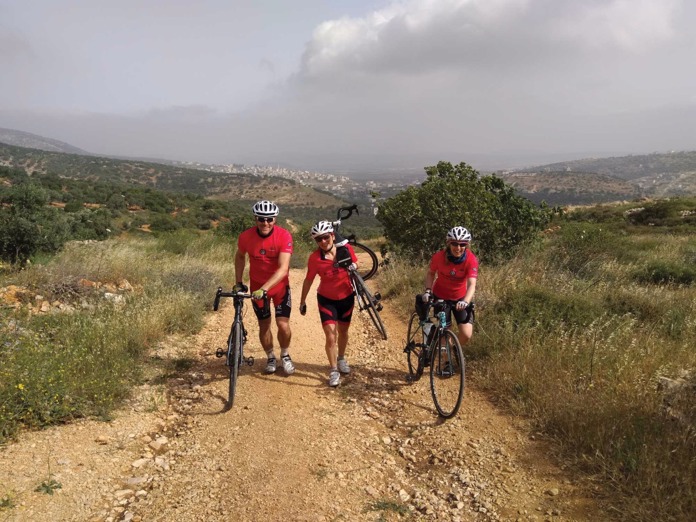
Taking the rough with the smooth:
Three Amos Road Club members walking with their bikes.
Chris explains that this is the only class of West Bank community where Palestinians have full control over both civil and military affairs. The message is fear and mistrust. We see this again and again, yet when we enter Area A communities throughout the trip we find nothing but friendly waves and shouted welcomes. A stark contrast to the busy, sour-faced lack of a welcome or even eye contact in the holy city of Jerusalem where we finished 4 days later.
We quickly learn to work together to share the slipstream, warn of potholes, and encourage each other especially to make sure we don’t dehydrate on the first morning.
In between we covered the width of the country in a day — it’s only about 60 miles across — and plunged down the descent into Jericho dropping from 3000ft to minus 1000ft in half an hour — a vast expanse of desert and hairdryer heat as you fall towards the Jordan. We were there to protest about the Giro d’Italia cycle race starting in Israel as a PR exercise to show a positive face to the world — while every day Palestinians are prevented from enjoying the same freedom to travel in their own land.
Amos coordinated a beautiful community fun ride around Jericho with kids and adults of all ages jumping on their bikes. Together with the speeches from local dignitaries it felt like an act of solidarity across the cultural divide — and also of penitence for Britain’s historical shame in abandoning the Palestinians to their fate over the last 100 years.
We were there to protest about the Giro d’Italia cycle race starting in Israel as a PR exercise to show a positive face to the world — while every day Palestinians are prevented from enjoying the same freedom to travel in their own land.
We visited extraordinary and tragic Palestinians who are somehow keeping the flame of hope of a better future alive despite their circumstances — the Freedom Theatre which fearlessly calls out both Israeli oppression and sometimes Palestinian complicity; and the haunting Sumud Freedom Camp where ancient cave and tented communities fight to prevent their land being taken by violence and legal abuses.
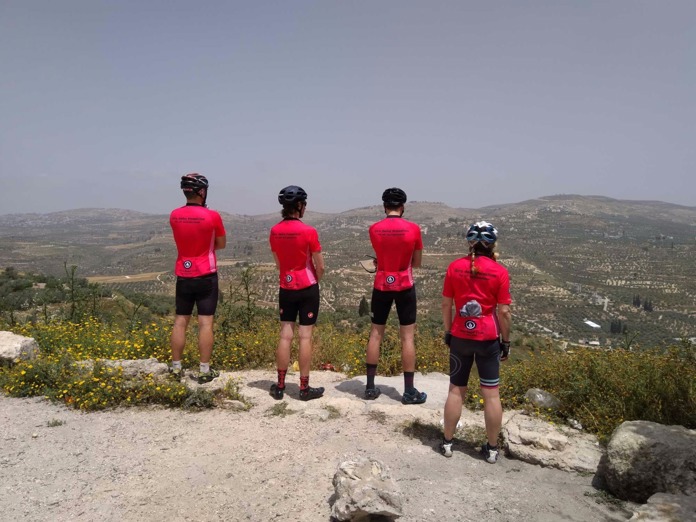
Breath-taking:
Looking out across the West Bank.
Staying at a guest house in the Aida refugee camp in Bethlehem (apparently the most tear-gassed place on earth), we had the joy of meeting a bunch of Palestinian kids on the way to school who flocked around us to poke the bikes and ask questions — but all under the shadow of the monstrous and illegal Separation Wall which dominates and divides their community.
The falafel wraps were out of this world. And if you weaken, you can even have a cold beer at the end of the day from the fantastic Taybeh brewery — an epic story in itself which illustrates the realities of living and doing business under occupation.
Further along the Wall you come to Banksy’s brilliant Walled Off Hotel where the graffiti levels reach a peak of intensity, anger and wit, and inside you can step into a parallel world of a colonial style bar where instead of hunting trophies there are mounted CCTV cameras and slingshots, a thought-provoking museum of the occupation, and challenging artworks. And of course, we did a few of the classic tourist spots such as floating in the Dead Sea, cycling up the (1 in 4) Mount of Olives from the Garden of Gethsemane, the Old City and into the illegally annexed East Jerusalem.
Other highlights included a fortuitous encounter with the manager of the Palestinian national cycling team, who recorded an interview for a cycling podcast and eating fabulous food both as a team and with some of the people we met on the tour. The falafel wraps were out of this world. And if you weaken, you can even have a cold beer at the end of the day from the fantastic Taybeh brewery — an epic story in itself which illustrates the realities of living and doing business under occupation.
Cycling is a perfect means of travel to get under the skin of a place and its realities. You really feel the land but you can also see a lot of it. The riding was challenging but everyone is there to help each other and learn. Amos Trust really knows the place, its people and its issues. And they love cycling. So if you love cycling and are interested in learning more about Palestine in a unique way, you should definitely go on the next Amos trip.









